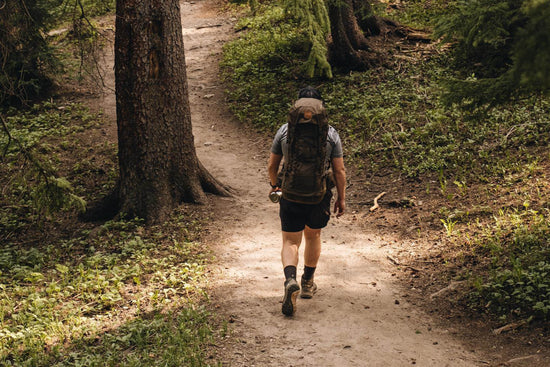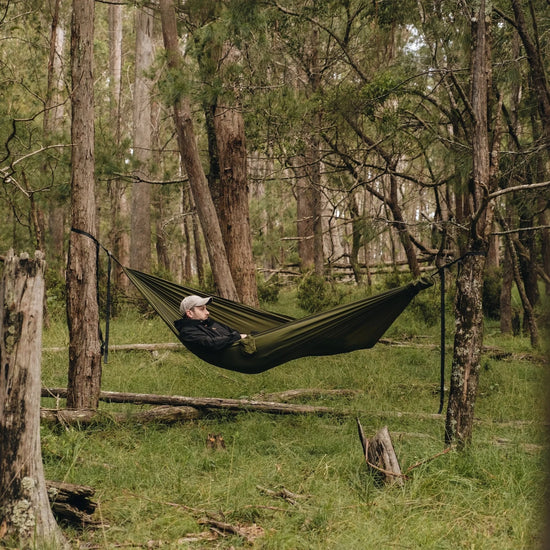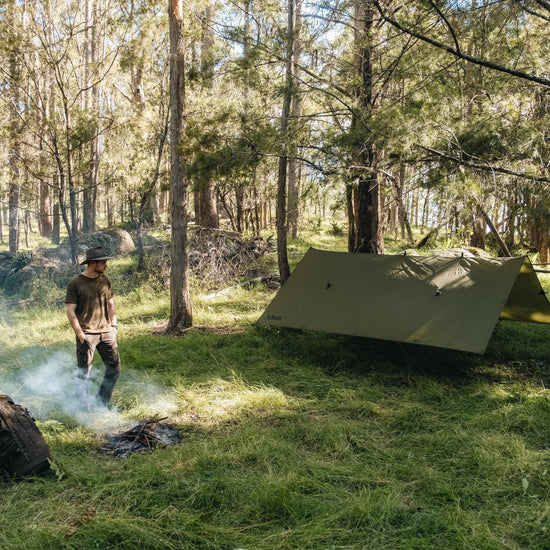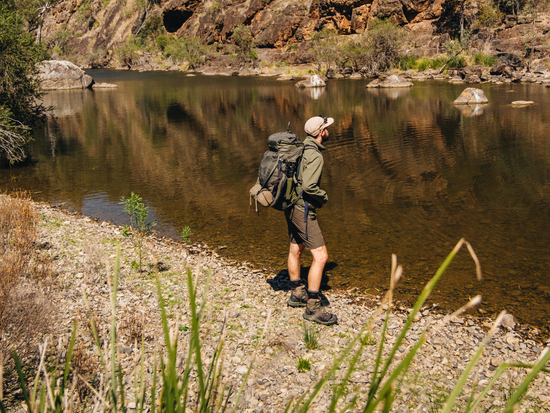Camping hammocks are incredibly quick and easy to set up – once you know how. It takes a little bit of effort to learn the ropes, but once you have, you’ll be able to effortlessly set up your hammock just about anywhere.
In this blog, we'll share the setup tips and tricks you need to know to set up your camping hammock like a pro. Whether you're a seasoned hammock camper or brand new to it, this guide will help you optimise your camping hammock setup for comfort, protection from the elements and safety.
How do you set up a camping hammock?
One of the reasons that we love hammock camping is the freedom it brings to your adventures. You can set up just about anywhere, as long as you have two anchor points.
But, like any adventure, it is important to go in prepared. We recommend doing some research to make sure the location is suitable for hammock camping. Once you’ve done the groundwork for your adventure and packed your hammock camping gear, it is time to hit the trail.
Here are the essential steps to setting up your camping hammock:

1. Look for a suitable campsite.
Scout around for an area with trees that look strong and healthy. Fortunately, the ground doesn’t have to be flat beneath you, so you can camp on sloping surfaces. But, remember to only ever set your hammock up as high as you are willing to fall. Although the chances of injury in your hammock are very low, always strive to make decisions that minimise risk.
2. Choose your anchors.
Once you’ve located a promising location, select two strong trees that are around 4 metres apart, or at least 60-80 cm longer than your hammock’s length. Take a moment to look up, checking that there are no dead branches or other hazards above you.
3. Attach your suspension straps.
Attach the straps around the trees about 1.2-1.6 metres up from the ground. You are aiming to have the lowest point of your hammock at a height that you’ll be comfortable getting in and out from, usually around 90cm off the ground. When you sit in your hammock, your feet should be able to rest flat on the ground, without the edge of the hammock cutting uncomfortably into your legs.

4. Hang your hammock between your suspension straps.
Connect your hammock to your suspension straps, aiming to have the suspension straps at about 30°degrees from the anchor points. Most hammock campers find this to be the most comfortable angle for sleeping. Using hammock straps with built-in connector loops and carabiners will make it easier to adjust your hammock to hang at that perfect height.
5. Fine tune your setup.
Now that you’ve got everything in place, double check that everything is secure. Sit slowly onto your hammock, making sure it can hold your weight, then lie down on a slight diagonal. Your body should be resting close to flat, not bending or dipping through the middle. Take the time to make minor adjustments to enhance your comfort, such as lifting the foot end of the hammock up a little higher or altering the tension slightly until it feels just right.
6. Fix a ridgeline above your camping hammock to attach your tarp and/or bug net.
If you are camping with a tarp or bug net, then you’ll need to run a cord between your anchor trees to form a taut ridgeline above the hammock. We suggest securing your ridgeline about 20-30 cm above the suspension straps so that you have space to move around under your tarp and/or bug net.
7. Make your bed.
Now your camping hammock is securely set up, you can make it comfy. Depending on what hammock camping gear you are using, you might attach your underquilt to the underside of your hammock and place your sleeping mat and top quilt or sleeping bag inside.

8. Add the finishing touches.
Make any final adjustments to your setup, such as adding a gear loft or groundsheet beneath you. If you are using a groundsheet in wet weather, make sure that it is completely covered by the tarp above you so that water does not collect on the surface.
9. Leave no trace.
As always, you have a responsibility to take care of the natural environment you are enjoying. Take steps to minimise your impact by using tree-friendly suspension straps and leave everything as you found it when you are done.
10. Clean, dry and store your gear.
After every adventure, clean your hammock camping gear and allow it to dry thoroughly before storing it in a cool, dry place away from direct sunlight.
Our final say on camping hammock setup
With these tips, you can streamline your hammock camping setup and optimise your comfort.
But, like anything new, setting up a camping hammock can take a bit of practice to get it right – but that is all a part of the fun.
We suggest doing a few trial runs before you jump straight into an overnight hike with your new hammock. Head out for a short hike where you can set up your hammock. Try things out, make adjustments and take note of what configuration is the most comfortable for you.

















